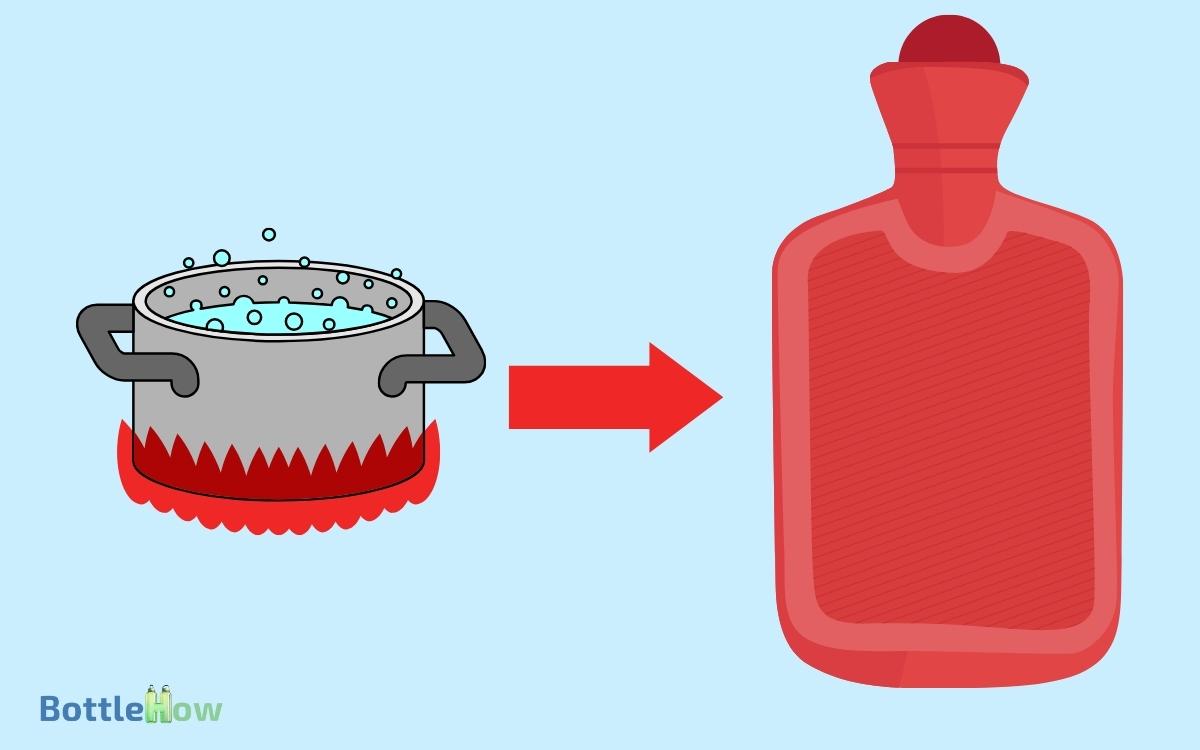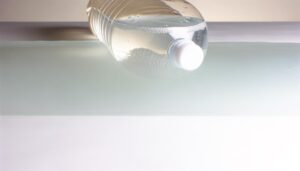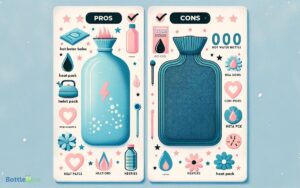Can You Put Boiling Water in a Hot Water Bottle? Explained!
You should avoid putting boiling water in a hot water bottle due to substantial safety and material risks.
Boiling water can damage the hot water bottle by causing structural failures, microfractures, and seal integrity compromises. This increases the likelihood of leaks and thermal burns.
Filling the bottle with water above 60°C (140°F) can lead to material degradation and brittleness.
It’s safer to use water between 40°C (104°F) and 60°C (140°F) to prevent injury and prolong the lifespan of your hot water bottle. If you want to learn more about safe practices and alternatives, continue exploring.

Key Takeaways
Risks of Boiling Water
Handling boiling water demands utmost caution, proper safety measures, and awareness of potential dangers.
Always use insulated gloves and guarantee a stable, non-slip surface to mitigate these risks, enhancing overall safety and preventing severe injuries.
Boiling water poses several risks, including the potential for severe burns and scalds when mishandled.
If boiling water contacts your skin, the high temperature can cause first-degree, second-degree, or even third-degree burns, necessitating immediate medical attention.
Additionally, steam generated from boiling water can cause scalds, leading to blistering and intense pain.
When transferring boiling water, you risk accidental spills, increasing the likelihood of injury. Using boiling water in confined spaces can also lead to steam buildup, creating a hazardous environment.
Material Limitations
You must consider the heat resistance limits of the materials used in hot water bottles, as many can’t withstand the temperatures of boiling water.
Material durability concerns also arise, as repeated exposure to high temperatures can degrade the integrity of the bottle. These factors increase the risk of rupture or leaks, posing potential safety hazards.
Heat Resistance Limits
Understanding the heat resistance limits of materials used in hot water bottles is essential to ensuring their safe and effective use.
Most hot water bottles are made from rubber or thermoplastic, each with specific thermal tolerance.
Rubber can generally withstand temperatures up to 100°C (212°F), while thermoplastic can endure slightly higher temperatures, around 110°C (230°F).
However, exposing these materials to boiling water (100°C/212°F) repeatedly can cause degradation over time.
| Material | Maximum Temperature | Risk Level |
|---|---|---|
| Rubber | 100°C (212°F) | Moderate |
| Thermoplastic | 110°C (230°F) | Low |
Ensuring you stay within these temperature limits will help maintain the integrity and longevity of your hot water bottle, preventing potential hazards like leaks or bursts.
Material Durability Concerns
Prolonged exposure to high temperatures can greatly compromise the durability of materials used in hot water bottles, leading to issues such as material fatigue and eventual failure.
When you repeatedly expose a hot water bottle to boiling water, several material limitations become evident:
- Thermal Degradation: Continuous high temperatures can cause the rubber or thermoplastic to break down, reducing its elasticity.
- Stress Cracking: The constant expansion and contraction from temperature changes can create micro-cracks, weakening the material.
- Seal Integrity: The seals and seams are particularly vulnerable, as they may lose their adhesive properties over time.
Understanding these concerns allows you to make informed decisions about the safe use of hot water bottles, ensuring longevity and preventing accidental injuries.
Potential Burns
You should be aware that using boiling water in a hot water bottle greatly increases the risk of thermal burns. It’s essential to adopt safe handling practices, such as allowing the water to cool slightly before filling the bottle and using a cover to protect your skin.
Ensuring proper handling can mitigate these risks and provide a safer experience.
Skin Contact Risks
Exposing skin to a hot water bottle filled with boiling water can result in severe thermal burns, necessitating immediate medical attention.
The risk stems from the high temperature of boiling water, which can cause first-degree, second-degree, or even third-degree burns upon contact.
These injuries aren’t only painful but can lead to complications such as:
- Infection: Burned skin is susceptible to bacterial invasion, increasing infection risk.
- Scarring: Significant burns can result in permanent scarring, affecting skin appearance and texture.
- Nerve damage: Severe burns can harm underlying nerves, leading to long-term sensory impairment.
Understanding these risks underscores the importance of careful handling. Always consider the temperature of the water and its potential impact on your skin to prevent serious injuries.
Safe Handling Tips
To minimize the risk of thermal burns, always wait for the water to cool slightly before filling the hot water bottle.
Avoid using boiling water as it increases the risk of the rubber deteriorating and potentially causing leaks.
When handling the bottle, make sure you grip it firmly but gently to prevent accidental spills. It’s important to fill the bottle only up to two-thirds capacity to allow for expansion and reduce pressure on the seams.
Utilize a funnel to avoid splashes and burns during filling. After sealing, check for leaks by holding the bottle upside down.
Always wrap the bottle in a cloth cover to prevent direct skin contact, further minimizing burn risks.
Structural Damage
Significant structural damage to a hot water bottle can occur when boiling water is used, compromising its integrity and safety.
The material, typically rubber or PVC, isn’t designed to withstand extreme temperatures, leading to:
- Deformation: The high heat can cause the material to lose its shape, making the bottle less effective.
- Brittleness: Exposure to boiling water can make the material brittle, increasing the risk of cracks and tears.
- Weakening of Seams: The seams where the bottle is joined can weaken, reducing its ability to contain hot water safely.
You should always follow the manufacturer’s guidelines, usually recommending water well below boiling point.
Using boiling water not only shortens the lifespan of the bottle but also poses a significant risk to your safety.
Leakage Issues
Leakage issues can arise when a hot water bottle is filled with boiling water, leading to potentially hazardous situations.
The extreme temperature can compromise the integrity of seals and seams, causing them to weaken or fail.
When rubber or thermoplastic materials are exposed to boiling water, they can expand excessively, resulting in microfractures or complete ruptures.
These structural failures can cause hot water to leak, posing a risk of burns or scalding. Additionally, the pressure buildup from steam can exacerbate these leaks.
Regular inspection of your hot water bottle for any signs of wear or damage is essential. Ensuring the bottle’s cap is properly secured can also mitigate leakage risks, but it doesn’t fully eliminate the potential hazards.
Proper Filling Temperature
You should aim to fill your hot water bottle with water at a temperature of approximately 42-45 degrees Celsius, as this range is best for safety and comfort.
Using boiling water poses significant risks, including the potential for burns and material degradation.
Adhering to safe filling guidelines guarantees the longevity of the hot water bottle and reduces the likelihood of accidents.
Ideal Water Temperature
The best filling temperature for a hot water bottle is typically between 120°F (49°C) and 140°F (60°C) to guarantee both safety and efficacy.
This range ensures ideal heat retention while minimizing the risks associated with higher temperatures.
When filling your hot water bottle, adhere to these guidelines to maximize its benefits:
- Heat Retention: Water within this temperature range provides sustained warmth for extended periods.
- Material Integrity: Excessive heat can degrade the rubber or thermoplastic material of the bottle, decreasing its lifespan.
- Safety: Filling the bottle with water within this range minimizes the risk of burns and scalds.
Risks of Boiling Water
While maintaining the ideal temperature range is important, using boiling water in a hot water bottle poses noteworthy risks that must be avoided.
Boiling water, at 100°C (212°F), can cause the material of a hot water bottle to degrade, leading to potential ruptures.
This degradation can compromise the structural integrity, increasing the likelihood of leaks or bursts.
Additionally, the high temperature can cause severe burns upon contact with skin, posing a serious safety hazard.
The rapid thermal expansion of boiling water can also create excessive internal pressure, further amplifying the risk of failure.
Hence, it’s important to understand that filling a hot water bottle with boiling water isn’t advisable, as it significantly elevates the risk of injury and equipment damage.
Safe Filling Guidelines
Maintaining a proper filling temperature, typically between 40°C (104°F) and 60°C (140°F), greatly reduces the risks associated with using a hot water bottle.
This temperature range guarantees ideal thermal comfort while minimizing the risk of burns or material degradation.
When filling your hot water bottle, always adhere to the following guidelines:
- Use a thermometer: Accurately measure water temperature to stay within the safe range.
- Avoid boiling water: Boiling water can weaken the rubber, leading to leaks.
- Fill slowly: Prevent air pockets that can cause sudden bursts of steam.
Safer Alternatives
Frequently, opting for heat packs or electric heating pads can provide a safer alternative to using boiling water in a hot water bottle.
These devices eliminate the risk of burns and scalding from hot water spills, ensuring a controlled and consistent heat application.
Heat packs, often filled with materials like rice or gel, can be microwaved to a safe temperature. Electric heating pads offer adjustable temperature settings and automatic shut-off features, mitigating overheating risks.
Research indicates that these alternatives decrease the likelihood of accidental injuries while providing effective thermal therapy.
Using Warm Water
Opting to fill your hot water bottle with warm water greatly reduces the risk of burns and scalding. Warm water, typically ranging between 104°F (40°C) and 113°F (45°C), provides sufficient heat without posing notable hazards. Additionally, using a hot water bottle for warmth ensures lasting comfort without the dangers associated with boiling water. This simple precaution helps prevent accidental leaks or ruptures that could cause serious injuries. By consistently using warm rather than boiling water, you can safely enjoy the benefits of a hot water bottle for warmth on cold nights.
This method is also beneficial as it prolongs the life of your hot water bottle by minimizing material stress due to extreme temperatures.
Consider these advantages of using warm water:
- Enhanced Safety: Warm water noticeably decreases the risk of accidental burns.
- Material Longevity: Reduces wear and tear on the hot water bottle, extending its usability.
- Optimal Comfort: Provides a soothing, consistent warmth ideal for therapeutic purposes.
Best Practices
To guarantee the safe and effective use of your hot water bottle, you should consistently follow these best practices.
Always use water that has been allowed to cool for a few minutes after boiling to avoid damage to the material and potential burns.
Fill the bottle to a maximum of two-thirds capacity to prevent overexpansion. Make sure the stopper is tightly secured to avoid leakage.
Regularly inspect the hot water bottle for any signs of wear, such as cracks or brittleness, which could compromise its integrity.
When filling, hold the bottle upright and away from your body to minimize the risk of spills. Store the bottle in a cool, dry place away from direct sunlight to extend its lifespan.
Maintenance Tips
Regularly maintaining your hot water bottle is crucial for guaranteeing its longevity and safe use.
To extend its lifespan and maintain functionality, you should follow these evidence-based practices:
- Inspect: Frequently check for cracks or degradation in the rubber material. Micro-tears can lead to leaks and reduced heat retention.
- Clean: Rinse the bottle with a solution of mild soap and water. Avoid harsh chemicals that could deteriorate the rubber.
- Dry: After cleaning, make sure the bottle is thoroughly dried inside and out before storage to prevent mold growth.
When to Replace
Recognizing the signs that indicate it’s time to replace your hot water bottle is essential for ensuring safety and peak performance.
Over time, wear and tear can compromise the material integrity. Look for cracks, leaks, or uneven thickness. A hot water bottle past its prime may pose risks such as burns or ruptures.
| Sign | Emotional Impact |
|---|---|
| Cracks or Leaks | Concern for Safety |
| Discoloration | Doubt in Reliability |
| Uneven Thickness | Anxiety over Burns |
Replace your hot water bottle every two years or sooner if you notice any of these signs. Utilizing a compromised bottle can lead to hazardous situations.
Ensuring regular inspection and timely replacement fosters peace of mind and maintains peak performance.
Conclusion
Basically, using boiling water in a hot water bottle is similar to playing with fire; the risks far outweigh the benefits.
Material limitations can lead to structural damage, while potential burns and leakage issues pose serious safety concerns.
Opt for warm water, following best practices and maintenance tips to guarantee longevity and safety.
Replace the bottle when necessary to avoid any mishaps. Prioritizing safety and proper usage can keep you warm without the perilous implications.





